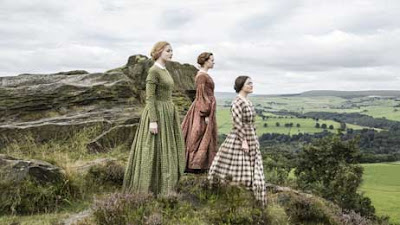Review by
Richard Wilcocks
Charlotte Brontë’s Villette,
which was recognised by knowledgeable readers in nineteenth century Brussels as
a close parallel for what actually happened when its author was teaching
cosseted Catholic girls in the Pennsionat, is not generally esteemed for its
plot, but for its exquisite characterisations and the way the shy, repressed,
unmarried and fiercely Protestant central character Lucy Snowe gives vent to
her thoughts and emotions throughout the novel. It is outstanding in Victorian
literature for its psychological intensity and its honest scrutiny of female
consciousness.
There are few dramatic possibilities in it, compared
to Jane Eyre, but it has, apparently,
been successfully adapted for radio. Stage and film versions have been sparse in
number and unmemorable. Therefore, the version scripted by Linda
Marshall-Griffiths for the Courtyard Theatre of the West Yorkshire Playhouse as
part of its current Brontë Season was keenly anticipated by many, especially
people who have read the novel. On the night I saw it, most of the Parsonage
staff were there. There had been a few clichéd journalistic comments previously
along the lines of “Brontë purists might not like this…” because this version
is set in the future. The summary of the new version sounded promisingly interesting,
and Linda Marshall-Griffiths is undoubtedly bold, brave and imaginative. In her
own words:
“In re-imagining Villette,
I asked myself who is the invisible woman now, who would she be in the future?
I began thinking of a clone – easily disposed of, created like a worker-ant,
identical and made purely to work. A clone that survived a pandemic that killed
her two identical sisters. As Charlotte Brontë used to catch glimpses of what
she thought was her sisters in paintings and crowds, my Lucy Snowe is haunted
by her own face and the past that both terrorises and holds her. I moved the
setting of Villette onto an archeological dig in the future. Lucy Snowe flees
her past to become part of a team looking for the bones of the Lady of Villette
– a survivor herself, she may hold the key to an ebola-like virus…” (from the YYP leaflet)
In the event, this play would have been most easily
followed by those Brontë purists, the ones in spotless white perhaps, the ones
who could compare the characters in the novel with those on stage and follow
the storyline, which on the whole adheres to the original pattern. There are just
five actors on stage (theatre economics of course), and much has been cut –
inevitably. For example Ginevra Fanshawe, here ‘Gin’ (and Polly) is played by
Amelia Donkor as a hedonistic dancer and slinky party-goer who prefers to go to
the Day of the Dead celebrations rather than hang around in a boring laboratory.
Day of the Dead? Is there a Mexican connection? Is it a linking reference to the bones of the Lady of Villette in the onstage archeological trench? Not clear. It is
just one of the things which lead to possible confusion, because the play is hard
to get to grips with and occasionally incoherent. Disbelief is not easily suspended. The
characters are sketchy and do not develop: Beck, for example, the equivalent of
Madame Beck, Charlotte Brontë’s version of the sly wife of the man she loved,
is played simply as a kind of workplace bully with an obsession for
surveillance by a very under-used Catherine Cusack. Nana Amoo-Gottfried gives us
the makings of a good, amiable John Bretton, and should also have been offered more
material through which to display his talents.
 |
| Amelia Donkor (Gin) and Laura Elsworthy (Lucy Snowe) |
After the first quarter of an hour or so, when I was
wondering whether this was something out of Doctor
Who, Laura Elsworthy, playing Lucy Snowe, was filling me with admiration
for her strenuous efforts to portray a journey out of repression and into the realm of
love, but she became wearing after a while, especially towards the end of the
over-long first half, when she is placed at a raised front corner and engages directly
with the audience. As an actor, she must have had some problems getting into the mind of one
of three identical clones created by a scientist father (her two sisters, named
Esme and Ashe, are dead) or showing that she has real sparks of humanity. Elsworthy
does her best with what she is given, but her clunky, awkward utterances, her
jerky movements and her lengthy agony-stricken diatribes, delivered
expressionist-style, are just too much. And where did that Catholic priest come
from? A dream? Mexico?
The second half gave some relief. Lucy became much more
human, and the audience even laughed as she sat on a blanket and opened a picnic
basket with the gauche Paul (Philip Cairns) to participate in a comically
awkward conversation, perhaps the best part of the play. Neither of the
characters knew what a picnic was, they had previously admitted, but the basket
was to hand and they soon found out.
The admirable boldness of the playwright’s
vision made this production watchable. On the night I saw it, a group of what
seemed to be sixth formers were chatting noisily afterwards. They had not read
the original and confessed to being confused, but they liked the play as a strange puzzle – and they were most intrigued
by the enigmatic ending. It might make a good television version one day.
Postings on this blog reflect the views of the individual writers.
To receive all blog postings free, put your email into the 'subscribe' box at top right of this page.












